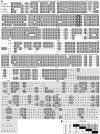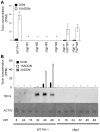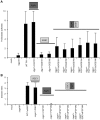The Wor1-like protein Fgp1 regulates pathogenicity, toxin synthesis and reproduction in the phytopathogenic fungus Fusarium graminearum
- PMID: 22693448
- PMCID: PMC3364952
- DOI: 10.1371/journal.ppat.1002724
The Wor1-like protein Fgp1 regulates pathogenicity, toxin synthesis and reproduction in the phytopathogenic fungus Fusarium graminearum
Abstract
WOR1 is a gene for a conserved fungal regulatory protein controlling the dimorphic switch and pathogenicity determents in Candida albicans and its ortholog in the plant pathogen Fusarium oxysporum, called SGE1, is required for pathogenicity and expression of key plant effector proteins. F. graminearum, an important pathogen of cereals, is not known to employ switching and no effector proteins from F. graminearum have been found to date that are required for infection. In this study, the potential role of the WOR1-like gene in pathogenesis was tested in this toxigenic fungus. Deletion of the WOR1 ortholog (called FGP1) in F. graminearum results in greatly reduced pathogenicity and loss of trichothecene toxin accumulation in infected wheat plants and in vitro. The loss of toxin accumulation alone may be sufficient to explain the loss of pathogenicity to wheat. Under toxin-inducing conditions, expression of genes for trichothecene biosynthesis and many other genes are not detected or detected at lower levels in Δfgp1 strains. FGP1 is also involved in the developmental processes of conidium formation and sexual reproduction and modulates a morphological change that accompanies mycotoxin production in vitro. The Wor1-like proteins in Fusarium species have highly conserved N-terminal regions and remarkably divergent C-termini. Interchanging the N- and C- terminal portions of proteins from F. oxysporum and F. graminearum resulted in partial to complete loss of function. Wor1-like proteins are conserved but have evolved to regulate pathogenicity in a range of fungi, likely by adaptations to the C-terminal portion of the protein.
Conflict of interest statement
The authors have declared that no competing interests exist.
Figures








Similar articles
-
A mitogen-activated protein kinase gene (MGV1) in Fusarium graminearum is required for female fertility, heterokaryon formation, and plant infection.Mol Plant Microbe Interact. 2002 Nov;15(11):1119-27. doi: 10.1094/MPMI.2002.15.11.1119. Mol Plant Microbe Interact. 2002. PMID: 12423017
-
The velvet gene, FgVe1, affects fungal development and positively regulates trichothecene biosynthesis and pathogenicity in Fusarium graminearum.Mol Plant Pathol. 2012 May;13(4):363-74. doi: 10.1111/j.1364-3703.2011.00755.x. Epub 2011 Oct 20. Mol Plant Pathol. 2012. PMID: 22013911 Free PMC article.
-
The Golgin Protein RUD3 Regulates Fusarium graminearum Growth and Virulence.Appl Environ Microbiol. 2021 Feb 26;87(6):e02522-20. doi: 10.1128/AEM.02522-20. Print 2021 Feb 26. Appl Environ Microbiol. 2021. PMID: 33452023 Free PMC article.
-
Recent advances in genes involved in secondary metabolite synthesis, hyphal development, energy metabolism and pathogenicity in Fusarium graminearum (teleomorph Gibberella zeae).Biotechnol Adv. 2014 Mar-Apr;32(2):390-402. doi: 10.1016/j.biotechadv.2013.12.007. Epub 2014 Jan 2. Biotechnol Adv. 2014. PMID: 24389085 Review.
-
Function of pH-dependent transcription factor PacC in regulating development, pathogenicity, and mycotoxin biosynthesis of phytopathogenic fungi.FEBS J. 2022 Apr;289(7):1723-1730. doi: 10.1111/febs.15808. Epub 2021 Mar 26. FEBS J. 2022. PMID: 33751796 Review.
Cited by
-
R-SNARE FgSec22 is essential for growth, pathogenicity and DON production of Fusarium graminearum.Curr Genet. 2020 Apr;66(2):421-435. doi: 10.1007/s00294-019-01037-y. Epub 2019 Oct 30. Curr Genet. 2020. PMID: 31667538
-
A disseminated infection with the antifungal-multiresistant teleomorphic fungus Neocosmospora vasinfecta in a patient with acute B-lymphoblastic leukemia.Med Mycol Case Rep. 2013 Feb 9;2:44-7. doi: 10.1016/j.mmcr.2013.01.004. eCollection 2013 Feb 9. Med Mycol Case Rep. 2013. PMID: 24432214 Free PMC article.
-
Transcription Factors Encoded on Core and Accessory Chromosomes of Fusarium oxysporum Induce Expression of Effector Genes.PLoS Genet. 2016 Nov 17;12(11):e1006401. doi: 10.1371/journal.pgen.1006401. eCollection 2016 Nov. PLoS Genet. 2016. PMID: 27855160 Free PMC article.
-
Discovery and Transcriptional Profiling of Penicillium digitatum Genes That Could Promote Fungal Virulence during Citrus Fruit Infection.J Fungi (Basel). 2024 Mar 22;10(4):235. doi: 10.3390/jof10040235. J Fungi (Basel). 2024. PMID: 38667906 Free PMC article.
-
MaPac2, a Transcriptional Regulator, Is Involved in Conidiation, Stress Tolerances and Pathogenicity in Metarhizium acridum.J Fungi (Basel). 2025 Jan 28;11(2):100. doi: 10.3390/jof11020100. J Fungi (Basel). 2025. PMID: 39997395 Free PMC article.
References
-
- Goswami RS, Kistler HC. Heading for disaster: Fusarium graminearum on cereal crops. Mol Plant Pathol. 2004;5:515–525. - PubMed
-
- Ilgen P, Hadeler B, Maier FJ, Schafer W. Developing kernel and rachis node induce the trichothecene pathway of Fusarium graminearum during wheat head infection. Mol Plant Microbe Interact. 2009;22:899–908. - PubMed
-
- Kimura M, Tokai T, Takahashi-Ando N, Ohsato S, Fujimura M. Molecular and genetic studies of fusarium trichothecene biosynthesis: pathways, genes, and evolution. Biosci Biotechnol Biochem. 2007;71:2105–2123. - PubMed

